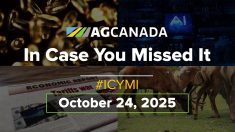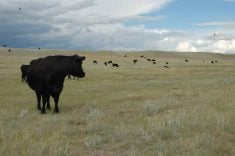Producers shouldn’t bet the family farm on long-range weather forecasts, according to officials.
“Although these are based on solid principles, the reliability is not absolute,” said Peter Dzikowski, a weather specialist with Alberta Agriculture.
“I would probably bet just a very little bit that these would be correct.”
According to Environment Canada, overall spring temperatures should be near normal while precipitation is expected to be above average. According to the spring forecast, released earlier this month, northwestern and southeastern portions of Alberta may see near normal precipitation, said Rene Servranckx.
Read Also

Manitoba community projects get support from HyLife
HyLife Fun Days 2025 donated $35,000 each to recreation and housing projects in Killarney, Steinach and Neepawa earlier this fall.
However, he admits long-range forecasts are not the organization’s fortŽ. When giving long-range forecasts, Environment Canada officials analyze data and decide whether temperatures and precipitation will be normal, above normal or below normal.
Their long-range predictions for Alberta springs are typically 40 to 50 percent accurate, depending on the region. Long-range precipitation forecasts for spring are also 40 to 50 percent accurate, said Servranckx.
“It’s not great but it’s better than chance,” he said.
However, summer forecast reliability for temperatures in the northwestern part of Alberta drops to 35 percent.
“That’s not much better than chance,” said Serv-ranckx, adding it’s 40 to 50 percent for the rest of the province. Long-range precipitation forecasts for summer also hover around 35 percent accurate.
“That essentially means there’s no skill in forecasting precipitation,” said Servranckx, adding precipitation forecasts take in more factors than temperature predictions and are usually less reliable.
The good news is Environment Canada is making progress on its predictions.
“Seasonal forecasts are like day-to-day forecasts were 10 years ago. Things are improving, so that’s encouraging.”
But while Environment Canada is often only a degree or two out on its next day forecast, reliable long-range forecasts are years away
“We hope to get a better understanding of what drives seasonal temperatures so the forecasts will improve in time,” said Servranckx.
From Alberta Agriculture’s research, Dzi-kowski found sources that suggest that ocean conditions point to average or slightly cooler spring temperatures and near normal precipitation for Alberta.
While Dzikowski acknowledges a demand for long-range forecasts he questions why.
“People want those forecasts but if I told them now what is going to happen on July 20 would it make a difference?”
He said if farmers want to base crop selection on expected anticipated conditions, they should keep their own records, he said. Then they can look at what the forecasts say and determine how the two compare.
“They should go with the tools available and combine them with their records, experience and judgment,” he said, adding farmers can find weather information and links to appropriate sites on Alberta Agriculture’s web page.














